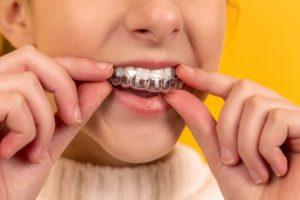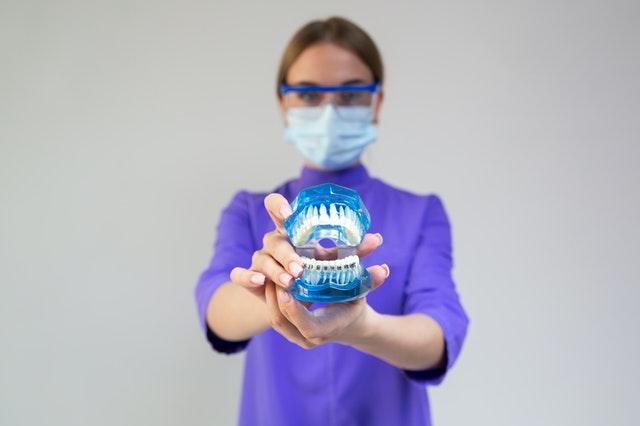Braces vs Invisalign
There are several different orthodontic options to straighten your teeth. The main question to ask your dental professional is traditional braces vs Invisalign. We’ll go over the several factors that play a key role in choosing what orthodontic treatment works best for you.
Table of Contents
The Process of Braces vs Invisalign
When deciding between braces vs Invisalign, it’s important to understand the basics of how the orthodontic process works. Each course of treatment is different and impacts certain lifestyle choices.
Traditional Braces
- The practice of traditional braces with brackets and wires really took off in the 1970s.
- Metal or acrylic brackets are bonded to each tooth with a metal wire that slides through to connect the dental arch.
- The rubber orthodontic bands anchor to the tooth and promote precise movements.
- Adjustment appointments are scheduled around 4-8 weeks to possibly change wires and apply new bands.
Invisalign Clear Aligner Therapy
- This orthodontic treatment wasn’t applied to practice until 1997.
- The initial appointment uses 3D imaging software and technology to create a series of fabricated plastic aligners for each arch.
- Tooth color buttons most likely will be placed on certain teeth to provide anchorage for the trays.
- Around every 1-2 weeks you will change trays to create shifts in the teeth. You will follow up with your dental professional at certain periods throughout to receive the next grouping of trays.
For more information on braces, check out our Comprehensive Guide to Braces.
Lifestyle Habits to Consider when Deciding Between Braces vs Invisalign
Traditional Braces

- Sticky candies and gum can get stuck in your brackets and band.
- Hard food can pop off your brackets. These foods include whole apples and carrots, ribs and chicken wings, pizza crust and toasted bread, and pretzels.
- Ice is very hard so the habit of chewing ice can pop off a bracket.
- Nail-biting and pen biting can bend the wire and debond brackets.
- Flossing habits will need to be adapted. Special ortho flossers and floss threaders will be needed to efficiently remove food and plaque between the teeth and under the wire.
Invisalign Clear Aligner Therapy

- You must take your trays out to eat. After eating you have to brush and floss before reinserting the tray. Any food and bacteria will be pressed up against the tooth and increase the cavity risk.
- No chewing gum or mints with the trays in the mouth.
- Only drink clear liquids with the trays in. Even the lightest colored liquid can stain the trays that you’re stuck with for 1-2 weeks.
- You must wear the clear aligner tray for 22 hours a day to be efficient. Not doing so will prolong treatment.
- Initially wearing trays can come with a lisp until your tongue gets used to the new placement. This can come with each change in trays and may last up to 24-48 hours.
Advantages of Braces vs Invisalign
When considering your choice between braces vs Invisalign, both are viable options. Each system has positives that come down to what best suits your lifestyle.
Either way, the end result will be a healthier alignment that will need a retainer to keep your smile in place.
Pros of Traditional Brackets
- You do not have to worry about being disciplined wearing removable trays and keeping track of them.
- Unique options to customize colored bands that change with adjustments. Check out our Best Braces Color article.
Pros of Invisalign Clear Aligner Trays
- The clear aligner look may be more aesthetically pleasing depending on your outlook.
- Your dental professional will give you several series of trays at once, making less frequent visits.
Braces vs Invisalign Cost
The average price of braces ranges anywhere from around $3000 up to around $7000. How much will be covered by your insurance is up to your individual plan.
The average price of Invisalign ranges anywhere from around $2000 up to around $6000. Just like with braces, how much will be covered by your insurance is up to your individual plan.
The difference in braces vs Invisalign cost will greatly depend on your dental insurance. It’s a good idea to contact your insurance provider before making a decision.
How to Choose Between Braces vs Invisalign

Orthodontic treatment has many benefits to your oral health. Straightening your teeth will decrease your risk of cavities and gum disease by making it easier to efficiently remove plaque and bacteria. Orthodontics can also help improve TMJ disorders.
The braces vs Invisalign decision ultimately depends on your dental professional’s recommendations and your lifestyle.
Braces vs Invisalign Questions to Consider
- How disciplined am I? Will I commit to wearing clear aligner trays for 22 hours or will I lose them? If not then we recommend traditional braces.
- How busy is my life during the day? Do I have time to brush and floss in the middle of the day? If not then we recommend traditional braces.
- Am I self-conscious about my smile and will brackets and a wire make me more self-conscious? If so then we recommend Invisalign clear aligner therapy.
- How much time do I have to dedicate to orthodontic dental visits? If not a lot, then Invisalign clear aligner therapy may work better.
- Does my insurance have orthodontic coverage for my age and do I qualify? Will it cover Invisalign clear aligner treatment or only traditional brackets?
For more information, visit the American Association of Orthodontists.
Frequently Asked Questions
Which is better to get Invisalign or braces?
When debating braces vs Invisalign, both are great options. Not all candidates for orthodontic treatment qualify for Invisalign. Consult your dental professional to see what fits best with your alignment goals and lifestyle.
Do braces work faster than Invisalign?
The speed of your orthodontic treatment depends on the condition of your teeth and what the goals are. Invisalign is an efficient treatment but relies on patient discipline. If you do not wear your trays for 22 hours a day, expect a longer treatment period.
Take Home Smile Store
Visit our Take Home Smile store for educational brochures and other fun printables to help with oral hygiene. All products can be customized to fit your dental needs.



